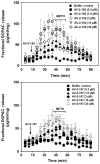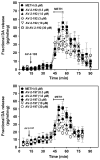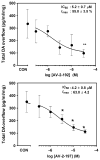The vesicular monoamine transporter-2: an important pharmacological target for the discovery of novel therapeutics to treat methamphetamine abuse
- PMID: 24484975
- PMCID: PMC4084610
- DOI: 10.1016/B978-0-12-420118-7.00002-0
The vesicular monoamine transporter-2: an important pharmacological target for the discovery of novel therapeutics to treat methamphetamine abuse
Abstract
Methamphetamine abuse escalates, but no approved therapeutics are available to treat addicted individuals. Methamphetamine increases extracellular dopamine in reward-relevant pathways by interacting at vesicular monoamine transporter-2 (VMAT2) to inhibit dopamine uptake and promote dopamine release from synaptic vesicles, increasing cytosolic dopamine available for reverse transport by the dopamine transporter (DAT). VMAT2 is the target of our iterative drug discovery efforts to identify pharmacotherapeutics for methamphetamine addiction. Lobeline, the major alkaloid in Lobelia inflata, potently inhibited VMAT2, methamphetamine-evoked striatal dopamine release, and methamphetamine self-administration in rats but exhibited high affinity for nicotinic acetylcholine receptors (nAChRs). Defunctionalized, unsaturated lobeline analog, meso-transdiene (MTD), exhibited lobeline-like in vitro pharmacology, lacked nAChR affinity, but exhibited high affinity for DAT, suggesting potential abuse liability. The 2,4-dicholorophenyl MTD analog, UKMH-106, exhibited selectivity for VMAT2 over DAT, inhibited methamphetamine-evoked dopamine release, but required a difficult synthetic approach. Lobelane, a saturated, defunctionalized lobeline analog, inhibited the neurochemical and behavioral effects of methamphetamine; tolerance developed to the lobelane-induced decrease in methamphetamine self-administration. Improved drug-likeness was afforded by the incorporation of a chiral N-1,2-dihydroxypropyl moiety into lobelane to afford GZ-793A, which inhibited the neurochemical and behavioral effects of methamphetamine, without tolerance. From a series of 2,5-disubstituted pyrrolidine analogs, AV-2-192 emerged as a lead, exhibiting high affinity for VMAT2 and inhibiting methamphetamine-evoked dopamine release. Current results support the hypothesis that potent, selective VMAT2 inhibitors provide the requisite preclinical behavioral profile for evaluation as pharmacotherapeutics for methamphetamine abuse and emphasize selectivity for VMAT2 relative to DAT as a criterion for reducing abuse liability of the therapeutic.
Keywords: AV-2-192; GZ-793A; Lobelane; Lobeline; Methamphetamine; VMAT2.
© 2014 Elsevier Inc. All rights reserved.
Conflict of interest statement
The University of Kentucky holds patents on the compounds described in the current work, some of which have been licensed by Yaupon Therapeutics/Ceptaris Inc. A potential royalty stream to LPD and PAC may occur consistent with the University of Kentucky policy. Both LPD and PAC are founders of, and have financial interest in, Yaupon Therapeutics/Ceptaris Inc.
Figures








References
-
- Andersen PH. Biochemical and pharmacological characterization of [3H]GBR 12935 binding in vitro to rat striatal membranes: Labeling of the dopamine uptake complex. Journal of Neurochemistry. 1987;48:1887–1896. - PubMed
-
- Ary TE, Komiskey HL. Phencyclidine: Effect on the accumulation of 3H-dopamine in synaptic vesicles. Life Sciences. 1980;26:575–578. - PubMed
Publication types
MeSH terms
Substances
Grants and funding
LinkOut - more resources
Full Text Sources
Other Literature Sources
Medical

